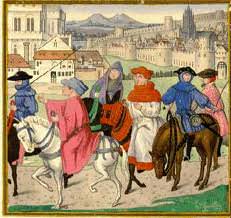Convents, Courts and Colleges: The Prioress and the Second Nun
Holloway, Julia Bolton
Equally in God’s Image: Women in the Middle Ages, Edited, Julia Bolton Holloway, Joan Bechtold, Constance S. Wright (Peter Lang, 1990)
Abstract
Sculpture becomes most interesting when showing two or more figures in tension against each other, rather than only one; as in the Alexandrian clustering of the Three Graces, one of whom gives, one who takes and one who both gives and takes, peaceably reconciling their warring opposites. It is wise to tell students not to write on only one Shakespearian dramatis persona, as their artistic existence is only achieved through their co-existence with the other characters in their play. Chaucer similarly compares and contrasts characters, in words in a book rather than with actors upon a stage or as forms and shapes in sculpture, in the Canterbury Tales. Literature is not reality, though it plays games with codes of representation. We have, amongst that diverse pilgrimage cavalcade, the lusty Wife and the celibate Clerk, the Benedictine Monk and the Franciscan Friar, the young and jovial Kentish Miller and the elderly and choleric Norfolk Reeve, and a host of others. Some personify occupations in competition with each other, others represent the tension of worldly hierarchies, the experienced Knight accompanied by the apprentice Squire, the Prioress, taking first place, prior, with the Second Nun, taking second. Chaucer’s Prioress is Gothic, his Second Nun, Romanesque.
Convents, Courts and Colleges: The Prioress and the Second Nun
Holloway, Julia Bolton
Equally in God’s Image: Women in the Middle Ages, Edited, Julia Bolton Holloway, Joan Bechtold, Constance S. Wright (Peter Lang, 1990)
Abstract
Sculpture becomes most interesting when showing two or more figures in tension against each other, rather than only one; as in the Alexandrian clustering of the Three Graces, one of whom gives, one who takes and one who both gives and takes, peaceably reconciling their warring opposites. It is wise to tell students not to write on only one Shakespearian dramatis persona, as their artistic existence is only achieved through their co- existence with the other characters in their play. Chaucer similarly compares and contrasts characters, in words in a book rather than with actors upon a stage or as forms and shapes in sculpture, in the Canterbury Tales. Literature is not reality, though it plays games with codes of representation. We have, amongst that diverse pilgrimage cavalcade, the lusty Wife and the celibate Clerk, the Benedictine Monk and the Franciscan Friar, the young and jovial Kentish Miller and the elderly and choleric Norfolk Reeve, and a host of others. Some personify occupations in competition with each other, others represent the tension of worldly hierarchies, the experienced Knight accompanied by the apprentice Squire, the Prioress, taking first place, prior, with the Second Nun, taking second. Chaucer’s Prioress is Gothic, his Second Nun, Romanesque.
existence with the other characters in their play. Chaucer similarly compares and contrasts characters, in words in a book rather than with actors upon a stage or as forms and shapes in sculpture, in the Canterbury Tales. Literature is not reality, though it plays games with codes of representation. We have, amongst that diverse pilgrimage cavalcade, the lusty Wife and the celibate Clerk, the Benedictine Monk and the Franciscan Friar, the young and jovial Kentish Miller and the elderly and choleric Norfolk Reeve, and a host of others. Some personify occupations in competition with each other, others represent the tension of worldly hierarchies, the experienced Knight accompanied by the apprentice Squire, the Prioress, taking first place, prior, with the Second Nun, taking second. Chaucer’s Prioress is Gothic, his Second Nun, Romanesque.
Click here to read this article from Equally in God’s Image: Women in the Middle Ages
Subscribe to Medievalverse
Related Posts